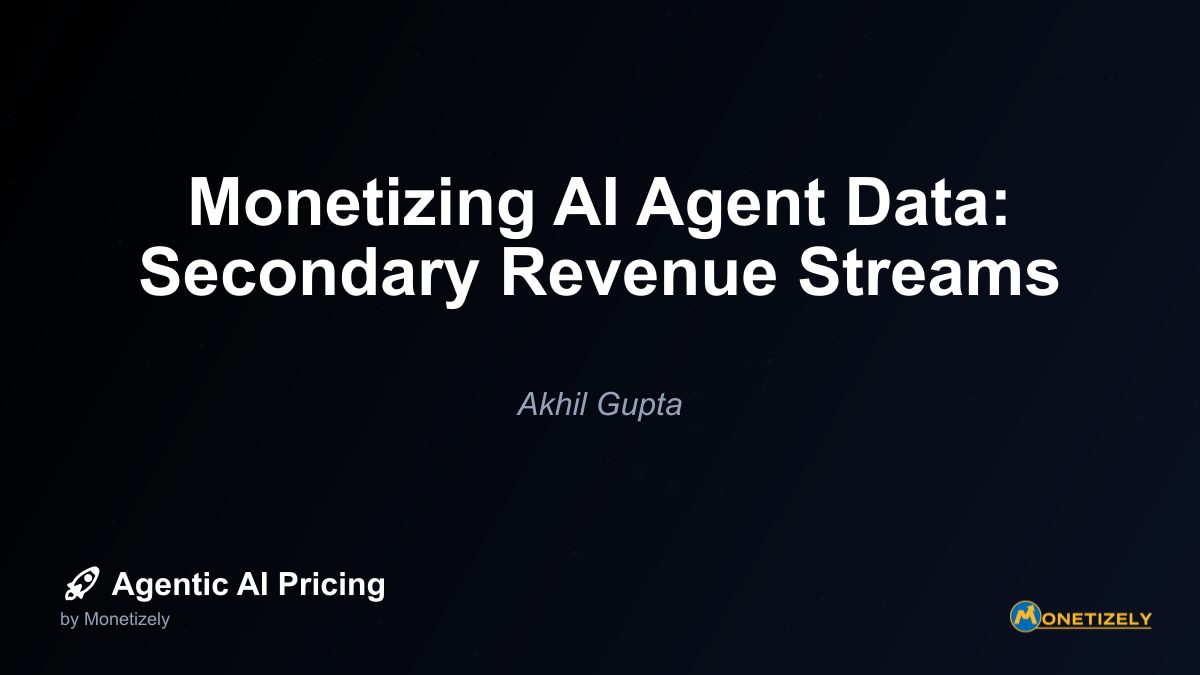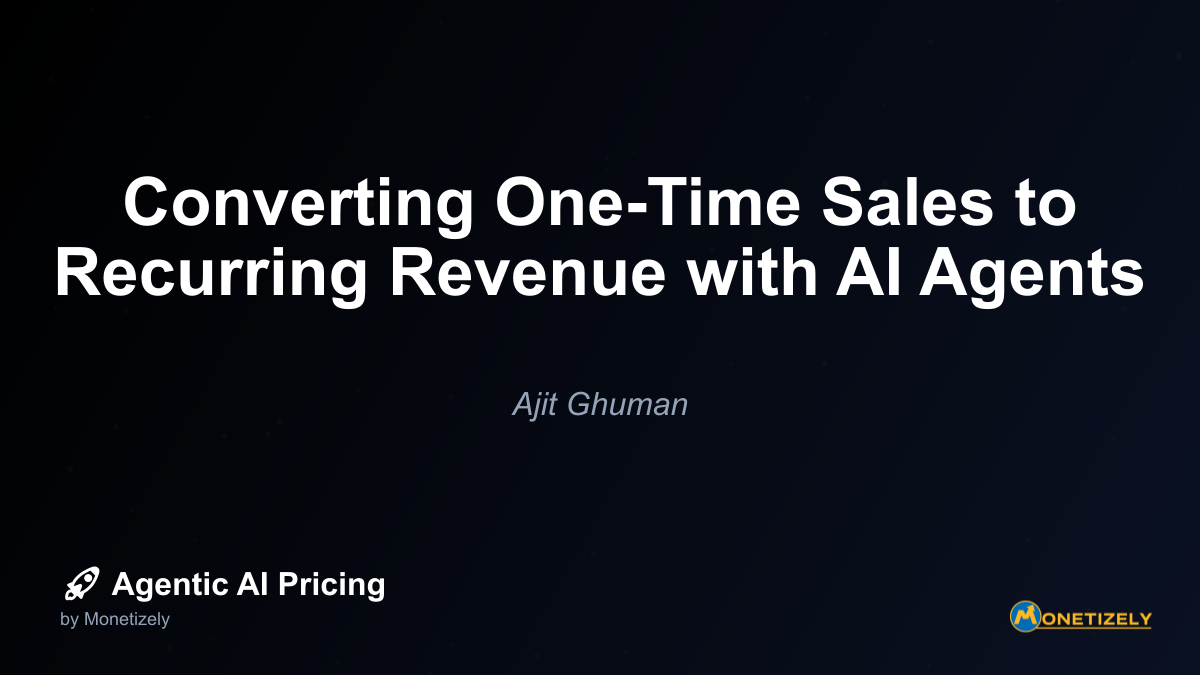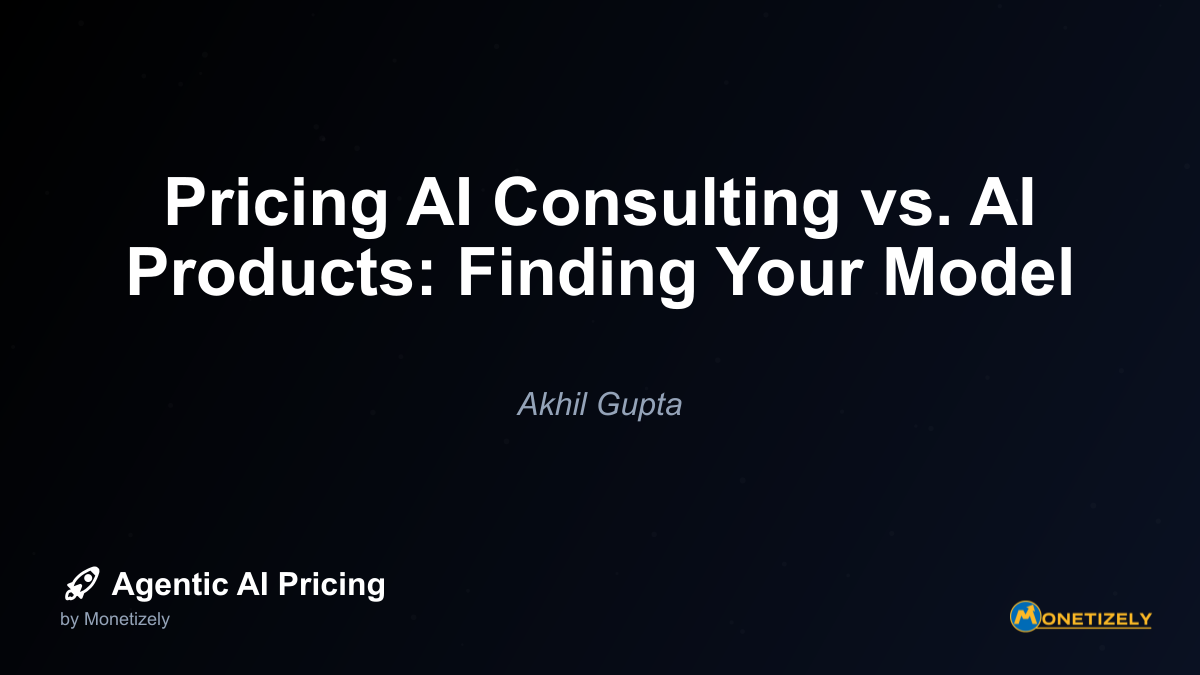· Akhil Gupta · Business Models · 12 min read
Monetizing AI Agent Data: Secondary Revenue Streams
AI and SaaS Pricing Masterclass
Learn the art of strategic pricing directly from industry experts. Our comprehensive course provides frameworks and methodologies for optimizing your pricing strategy in the evolving AI landscape. Earn a professional certification that can be imported directly to your LinkedIn profile.

In today’s data-driven economy, AI agents generate vast amounts of valuable information through their interactions and operations. Forward-thinking organizations are discovering that this data represents not just operational value but potentially lucrative secondary revenue streams. When approached ethically and strategically, AI agent data can be monetized to create sustainable business models that complement primary revenue sources.
The Growing Value of AI Agent Data
AI agents—whether customer service chatbots, virtual assistants, or specialized autonomous systems—continuously generate and process data through their operations. This data encompasses interaction patterns, user preferences, market insights, and specialized domain knowledge. As these systems proliferate across industries, the aggregate data they produce represents a goldmine of potential value.
According to recent McKinsey research, by 2026, approximately 75% of businesses will use generative AI for synthetic customer data creation, compared with under 5% in 2023. This dramatic increase reflects the growing recognition of AI-generated data’s value beyond its primary purpose.
The AI agents market itself is experiencing explosive growth, valued at approximately $5.25 billion in 2024 and forecast to reach $7.84 billion in 2025. With a projected compound annual growth rate (CAGR) of 46.3% between 2025-2030, the market could exceed $52 billion by 2030. This growth trajectory underscores the expanding opportunities for data monetization strategies.
Ethical Foundations for AI Data Monetization
Before exploring monetization strategies, organizations must establish robust ethical frameworks for AI agent data use. These frameworks balance commercial objectives with privacy concerns, regulatory requirements, and stakeholder trust.
Privacy and Consent Considerations
Data privacy forms the cornerstone of ethical AI data monetization. Organizations must implement clear consent mechanisms that inform users about data collection practices and intended uses. This includes:
- Transparent data policies explaining what information is collected and how it will be used
- Opt-in mechanisms for secondary data uses beyond the primary service
- Granular consent options allowing users to control specific data sharing
- Regular privacy policy updates reflecting evolving data practices
The regulatory landscape continues to evolve, with frameworks like GDPR in Europe and CCPA in California establishing stringent requirements for personal data processing. These regulations mandate principles like data minimization, purpose limitation, and explicit consent—all of which must be incorporated into monetization strategies.
Anonymization and De-identification Techniques
To mitigate privacy risks while preserving data utility, organizations employ various anonymization and de-identification techniques:
- Data Aggregation: Combining individual data points into collective statistics that cannot be traced to specific users
- Pseudonymization: Replacing identifying information with artificial identifiers
- Differential Privacy: Adding calibrated noise to data to protect individual privacy while maintaining statistical validity
- K-anonymity: Ensuring that each record is indistinguishable from at least k-1 other records
These techniques help organizations navigate the tension between data utility and privacy protection. However, they must be implemented with care, as research has shown that even anonymized data can sometimes be re-identified through correlation with external datasets.
Responsible AI Frameworks
Beyond privacy considerations, comprehensive ethical frameworks for AI data monetization should address:
- Fairness and Bias: Ensuring that monetized insights don’t perpetuate or amplify existing biases
- Transparency: Providing clear explanations of how AI-generated data is being used
- Accountability: Establishing governance structures with clear responsibilities for ethical data use
- Value Distribution: Considering how to fairly distribute the value created from user-generated data
The ETHOS framework, increasingly adopted by industry leaders, advocates embedding ethical principles directly into AI agent architecture. This ensures respect for human dignity, privacy, and ethical legal norms, with transparency and accountability as enablers of trust.
Primary Monetization Models for AI Agent Data
Organizations can pursue several business models to generate revenue from AI agent data, each with distinct characteristics and implementation requirements.
Insights-as-a-Service (IaaS)
The Insights-as-a-Service model transforms raw data into actionable intelligence that clients can subscribe to on an ongoing basis. Rather than selling data itself, organizations package the valuable insights derived from AI agent interactions.
Implementation approach:
- Aggregate and analyze data across multiple AI agent deployments
- Identify patterns, trends, and actionable insights valuable to specific industries or use cases
- Develop user-friendly dashboards and reporting interfaces
- Package insights into tiered subscription offerings
Real-world example: Salesforce’s Einstein Copilot generates insights from CRM interactions that help sales teams identify opportunities, optimize processes, and improve forecasting accuracy. These insights are monetized through tiered subscription plans, with premium features like predictive lead scoring behind paywalls.
According to industry projections, IaaS is expected to account for 40% of data monetization revenue by 2027 as companies prioritize value-added data services over raw data access.
Synthetic Data Products
Synthetic data—artificially generated information that statistically mirrors real datasets without exposing sensitive details—represents a growing opportunity for monetization while addressing privacy concerns.
Implementation approach:
- Train generative AI models on proprietary data
- Generate synthetic datasets that preserve statistical properties while removing identifiable information
- Package synthetic data for specific use cases (training datasets, testing scenarios, simulation environments)
- Offer customization options for different customer needs
Real-world example: Healthcare organizations are increasingly generating synthetic patient data that maintains the statistical properties of real medical records without exposing actual patient information. These synthetic datasets can be sold to researchers, pharmaceutical companies, and AI developers who need realistic medical data for model training and testing.
The market for synthetic data is growing rapidly, with McKinsey projecting that by 2026, 75% of businesses will use generative AI for synthetic data creation.
Data Marketplaces and Exchanges
Data marketplaces facilitate the buying and selling of AI-generated data and insights, creating ecosystems where data producers and consumers can transact efficiently.
Implementation approach:
- Establish platforms for data listing, discovery, and transaction
- Implement quality assurance mechanisms and standardized formats
- Develop pricing models (subscription, pay-per-use, auction)
- Create trust mechanisms through ratings, reviews, and verification
Real-world example: HuggingFace has built a multi-tiered revenue model around its AI model marketplace, combining free open-source access with paid API services for inference, enterprise support, and high-volume packages. This marketplace approach generates sustainable revenue through diversified income streams while fostering a vibrant ecosystem.
Embedded Intelligence
This model embeds AI-generated insights directly into existing products and services, enhancing their value and justifying premium pricing.
Implementation approach:
- Identify how AI agent data can enhance existing offerings
- Integrate insights seamlessly into user workflows
- Create tiered pricing structures with AI-enhanced features in premium tiers
- Measure and communicate the additional value created
Real-world example: Starbucks uses AI for personalized customer recommendations through data-driven marketing offers, resulting in a 30% increase in overall ROI and a 15% lift in customer engagement. By embedding this intelligence into their customer experience, they create secondary revenue through improved conversion and higher average order values.
Advanced Monetization Strategies
Beyond basic models, several sophisticated approaches are emerging as organizations mature in their AI data monetization capabilities.
Dynamic and Outcome-Based Pricing
Traditional volume-based data pricing is giving way to value-based models that align costs with the outcomes data helps achieve.
Key characteristics:
- Pricing based on measurable business outcomes rather than data volume
- Risk-sharing arrangements where vendors only get paid for successful outcomes
- Continuous monitoring of performance metrics
- Adaptive pricing that adjusts based on demonstrated value
Implementation considerations: This approach requires sophisticated tracking mechanisms to measure outcomes accurately and attribute them to data usage. Organizations must define clear success metrics and establish baseline measurements for comparison.
Companies like PROS have implemented AI-powered dynamic SaaS pricing that adjusts rates based on real-time demand, resulting in a 12% revenue increase and improved customer retention.
Cross-Industry Data Syndication
Organizations can create value by combining AI agent data across industries to generate unique cross-domain insights.
Key characteristics:
- Collaboration between organizations in different sectors
- Identification of complementary datasets that create novel insights when combined
- Revenue-sharing arrangements between data contributors
- Privacy-preserving techniques for secure data sharing
Implementation considerations: Cross-industry syndication requires careful legal frameworks to govern data sharing, ownership of derived insights, and revenue distribution. Technical solutions for secure multi-party computation may be necessary to protect proprietary information.
Autonomous Data Marketplaces
Emerging technologies are enabling AI agents to autonomously negotiate, price, and deliver data in dynamic marketplaces.
Key characteristics:
- AI agents that represent data owners and purchasers
- Automated negotiation of terms, pricing, and usage rights
- Smart contracts to enforce agreements and handle payments
- Continuous optimization of pricing based on market conditions
Implementation considerations: This approach requires sophisticated AI capabilities and blockchain or similar technologies to ensure trust and transaction security. Organizations must develop clear policies governing how their AI agents negotiate on their behalf.
Technical Infrastructure for AI Data Monetization
Successful monetization requires robust technical infrastructure to collect, process, and deliver data products securely and efficiently.
Data Aggregation and Management Platforms
These platforms serve as the foundation for data monetization, enabling organizations to collect, organize, and prepare AI agent data for commercial use.
Key components:
- Data ingestion pipelines from multiple AI agent sources
- Storage solutions optimized for different data types and access patterns
- Data governance tools for managing access, retention, and compliance
- Quality assurance mechanisms to ensure data accuracy and completeness
Implementation best practices:
- Implement real-time data processing capabilities for time-sensitive insights
- Establish clear data taxonomies and metadata management
- Automate quality checks and anomaly detection
- Design for scalability as data volumes grow
Modern data aggregation platforms integrate contextual and intelligent orchestration, such as Model Chain Processors (MCPs), to manage data flows, tools, and memory in a structured manner, activating data monetization “just in time” to support live decisions without manual intervention.
Privacy-Enhancing Technologies
These technologies enable organizations to derive value from data while protecting individual privacy and ensuring regulatory compliance.
Key technologies:
- Advanced anonymization techniques
- Federated learning for distributed model training without centralizing sensitive data
- Homomorphic encryption allowing computation on encrypted data
- Secure multi-party computation for collaborative analytics without data sharing
Implementation best practices:
- Layer multiple privacy-enhancing technologies for defense in depth
- Regularly audit anonymization effectiveness against re-identification attacks
- Balance privacy protection with data utility based on use case requirements
- Stay current with evolving privacy-preserving techniques
Analytics and AI Infrastructure
Robust analytics capabilities transform raw AI agent data into valuable insights and products.
Key components:
- Machine learning pipelines for model training and deployment
- Real-time analytics engines for immediate insight generation
- Visualization tools for making insights accessible and actionable
- Integration capabilities with customer-facing applications
Implementation best practices:
- Design modular analytics pipelines that can be customized for different use cases
- Implement continuous learning systems that improve with new data
- Balance automation with human oversight for quality control
- Optimize for both batch and real-time analytics needs
Delivery and Monetization Platforms
These platforms handle the commercial aspects of data monetization, from packaging and pricing to delivery and billing.
Key components:
- Product catalogs for data offerings
- Pricing and packaging tools
- Subscription and usage management
- Billing and payment processing
- Customer analytics for understanding usage patterns
Implementation best practices:
- Design flexible pricing models that can adapt to market conditions
- Implement robust usage monitoring and metering
- Create seamless self-service experiences for data consumers
- Build analytics capabilities to optimize pricing and packaging
Case Studies: Successful AI Data Monetization
Several organizations have successfully implemented secondary revenue streams from AI agent data, offering valuable lessons for others embarking on similar journeys.
Salesforce: Embedded AI Insights
Implementation details: Salesforce embedded LLM-powered agents (Einstein Copilot) into CRM workflows for sales forecasting, email generation, and ticket triage. The company monetizes these capabilities through outcome-based pricing via tiered SaaS models, with premium features like predictive lead scoring behind paywalls.
Revenue impact: While specific revenue figures aren’t disclosed, the approach has demonstrably improved time-to-close, forecast accuracy, and sales efficiency for customers, justifying premium pricing.
Key lessons:
- Monetize by selling outcomes the AI improves, not just the agent itself
- Embed AI capabilities deeply into existing workflows
- Use tiered pricing to encourage adoption and upselling
SuperAGI: AI-Driven Sales Enhancement
Implementation details: SuperAGI deployed AI-driven sales agents for lead qualification, personalized outreach across channels (email, social media, SMS), and real-time analytics.
Revenue impact: The company achieved impressive results, including 25% pipeline growth, 30% boost in conversion rates, and 15% overall revenue increase. Omnichannel messaging raised customer engagement by 24% and sales by 12%.
Key lessons:
- Leverage personalized, omnichannel engagement
- Implement continuous KPI monitoring to optimize performance
- Focus on measurable outcomes that directly impact revenue
Caidera.ai: Multi-Agent Framework for Life Sciences
Implementation details: Caidera.ai created a multi-agent framework automating life-sciences marketing campaigns, including document ingestion, compliant copy generation, and validation.
Revenue impact: The implementation resulted in a 70% reduction in campaign build time and doubled conversion rates.
Key lessons:
- Automation can dramatically speed complex workflows
- Handling compliance and validation automatically creates significant value
- Multi-agent collaboration enables handling of complex, specialized tasks
Starbucks: Personalized Customer Recommendations
Implementation details: Starbucks implemented AI for personalized customer recommendations through data-driven marketing offers based on purchase history and preferences.
Revenue impact: The company achieved a 30% increase in overall ROI and a 15% lift in customer engagement.
Key lessons:
- Personalization at scale drives engagement and sales lift
- Secondary revenue comes from improved customer experience
- Data from everyday transactions can fuel powerful recommendation engines
Implementation Roadmap
Organizations looking to monetize AI agent data can follow a structured approach to develop and deploy successful strategies.
Assessment and Strategy Development
Key activities:
- Data inventory: Catalog available AI agent data, assessing volume, quality, uniqueness, and potential value
- Market analysis: Identify potential customers, their needs, and willingness to pay
- Competitive landscape: Understand existing offerings and differentiation opportunities
- Ethical and legal review: Assess privacy implications, regulatory requirements, and ethical considerations
- Business model selection: Choose appropriate monetization models based on data assets and market opportunities
Expected outcomes:
- Clear understanding of monetizable data assets
- Identified target markets and customer segments
- Selected business models with preliminary pricing strategies
- Risk assessment and mitigation plans
Technical Infrastructure Development
Key activities:
- Platform selection: Choose or develop appropriate data management, analytics, and delivery platforms
- Privacy engineering: Implement anonymization, synthetic data generation, and other privacy-enhancing technologies
- Integration architecture: Design connections between AI agents, data platforms, and delivery mechanisms
- Security implementation: Ensure robust protection for data throughout its lifecycle
- Analytics capabilities: Develop tools for transforming raw data into valuable insights
Expected outcomes:
- Secure, scalable infrastructure for data processing and delivery
- Privacy-preserving mechanisms that meet regulatory requirements
- Analytics capabilities that generate valuable insights
- Integration with existing systems and workflows
Product Development and Packaging
Key activities:
- Use case refinement: Develop detailed specifications for initial data products
- Prototype development: Create minimum viable products for testing
- Feedback collection: Gather input from potential customers
- Pricing strategy: Develop and test pricing models
- Product packaging: Create compelling offerings with clear value propositions
Expected outcomes:
- Well-defined data products aligned with market needs
- Validated pricing strategies
- Compelling packaging and positioning
- Initial customer interest and feedback
Go-to-Market Execution
Key activities:
- Sales enablement: Prepare materials and train sales teams
- Marketing campaign: Develop and execute awareness and demand generation activities
- Customer onboarding: Create smooth processes for customer setup and adoption
- Feedback mechanisms: Implement systems for collecting customer input
- Performance monitoring: Track key metrics for adoption, usage, and revenue
Expected outcomes:
- Growing customer base
- Increasing revenue from data products
- Valuable feedback for product improvement
- Performance metrics to guide future development
Continuous Improvement
Key activities:
- Usage analysis: Understand how customers use data products
- Product enhancement: Develop new features based on customer feedback
- Pricing optimization: Refine pricing strategies based on market response
- Expansion planning: Identify opportunities for new data products
- Technology updates: Implement advances in data processing, privacy, and analytics
Expected outcomes:
- Improved customer satisfaction and retention
- Optimized pricing and packaging
- Expanded product portfolio
- Enhanced technical capabilities
Challenges and Mitigation Strategies
Organizations implementing AI data monetization strategies face several common challenges. Understanding these challenges and planning appropriate mitigation strategies is essential for success.
Data Quality and Consistency
Challenge: AI agent data may be inconsistent, incomplete, or of variable quality, potentially undermining the value of derived insights.
Mitigation strategies:
- Implement robust data validation and cleansing processes
- Develop quality metrics and minimum standards for monetizable data
- Create feedback loops to improve data collection at the source
- Be transparent with customers about data limitations and confidence levels
Privacy and Regulatory Compliance
Challenge:
Co-Founder & COO
Akhil is an Engineering leader with over 16+ years of experience in building, managing and scaling web-scale, high throughput enterprise applications and teams. He has worked with and led technology teams at FabAlley, BuildSupply and Healthians. He is a graduate from Delhi College of Engineering and UC Berkeley certified CTO.
Pricing Strategy Audit
Let our experts analyze your current pricing strategy and identify opportunities for improvement. Our data-driven assessment will help you unlock untapped revenue potential and optimize your AI pricing approach.




